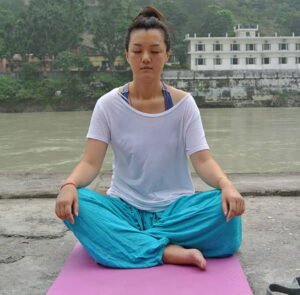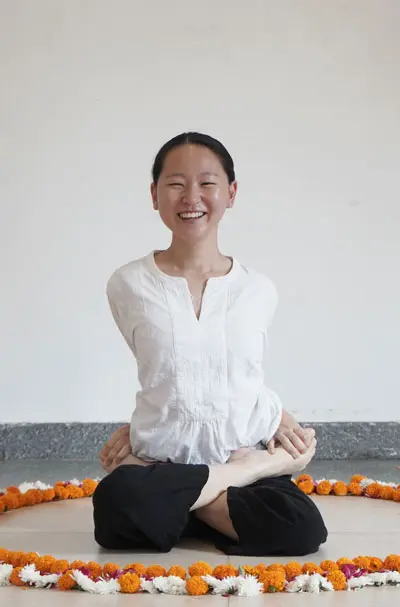- Padma – Lotus
- Asana – Pose
How To Do the Padmasana?
You can do this pose, extremely easily as a beginner in yoga. You can follow the instructions given below for a seamless modality.- You have to sit on the floor in the Staff pose, or Dandasana. Your legs have to be stretched outward in the beginning. Bend the right knee and carry it in your along with the foot, with your hands. Rotate the left leg from the hip and place the right one on the left leg’s hip crease.
- After, you have done that, you can bend your left leg at the knee. Do it in a manner similar to the right. Lift the shin a little bit, and guide it to the right and tuck it into the crease of the hip.
- Both your feet should be resting on the opposite thighs.
- You have to sit straight, with your sternal plate up and the spine elongated. You can take support from a folded blanket initially, to stop your spine from developing a hump.
- You have to keep both hands on each knee, in Gyan mudra if possible. This pose is supposed to bring enlightenment. So, this hand gesture is just apt. The Gyan mudra is also called Chin mudra. It mainly helps in developing focus. This is the most common mudra, used in seated meditation. It mainly aims at maintaining stability during the practice of asanas.
- You have to breathe slowly and comfortably as you do this practice.
Modifications and Variations of Padmasana
- You may be practicing yoga for the first time. So, it is best to listen to what your body says. Take it one step at a time. The one-legged Padmasana is one of the poses which you must undertake, to develop flexibility in the hamstrings and glutes. After that, when your legs are more flexible, you can do them together.
- You can also place blocks under the knees. At first, excess pressure on your ankles, may be a bad idea. So, you can get added support, by raising the level of the knees.
- Using a cushion or a blanket also helps in the initial days. It will help you to keep your buttocks in a proper position, which will, in turn, allow you to maintain the elongated and straight shape of the spine.
- You should start practicing this asana on a soft surface. This gives the legs more opportunity to loosen up.
Safety Precautions Decoded
For beginners, it is always advisable to practice under a trained expert. However, if you are unable to reach one, you can try these safety tips.- To get into the Padmasana or Lotus pose, you have to rotate the thighs outward from the hip socket. The socket is very lubricated for a few, and for others it is quite stiff. So, you should not force the pose.
- While practicing the pose, do not overstrain the legs and thighs. Moreover, you should always warm up, no matter which asana you are starting with.
- Try some of the hop openers like Cow face pose.
- Always practice Padmasana, with a lot of awareness and focus.
- If you had any form of knee injury, you cannot practice this asana.
- If you have an injury in the ankle or calf, then also you must not do Padmasana.
- If you have any back or spine problem, you must not do this asana, no matter how beneficial it is.
- Sciatica patients also must not perform the asana.
- Always stretch and then start this asana.
Benefits of Padmasana ( Lotus Pose)
- As you already know, this is a meditative asana. So, it is bound to relieve you of your stress and anxiety. It will also help you to release pent up feelings. Your mind will also be able to get rid of all the negative emotions. It reduces the secretion of stress hormones, when you practice regularly.
- It also helps you to fight insomnia. The deep breathing which goes along with it helps in the maintenance of emotional well-being and wellness.
- It also enhances your pelvic strength and flexibility, which helps in child birth. It is a great pose for pregnant women.
- The Lotus pose also strengthens the joints.
- It also leads to alleviation of digestion problems, as the abdomen area gets a gentle massage, when you practice this pose.

Deepen Your Yoga Practice with Hari Om Yoga Vidya School
Located in the heart of Rishikesh, Hari Om Yoga Vidya School is a place where ancient yogic wisdom meets modern teaching techniques. As a top yoga school in Rishikesh, we are committed to providing authentic, immersive yoga education in a peaceful, spiritual setting. Recognized as one of the best yoga schools in Rishikesh, we offer structured training programs designed to help you evolve in your practice, whether you are a beginner or an experienced yogi.
If you’re searching for a yoga school in Rishikesh that focuses on holistic learning, experienced teachers, and a supportive community, look no further!
Explore Our Yoga Teacher Training & Retreats
At Hari Om Yoga Vidya School, we offer a range of courses tailored for different levels of practitioners:
✅ 100-Hour Yoga Teacher Training in Rishikesh – A foundational course for those looking to begin their yoga journey.
✅ 200-Hour Yoga Teacher Training in Rishikesh – An internationally recognized certification for aspiring yoga teachers.
✅ 300-Hour Yoga Teacher Training in Rishikesh – Advanced training to deepen your practice and refine your teaching skills.
✅ 7-Day Yoga Retreat in Rishikesh – A rejuvenating escape into yoga, meditation, and self-discovery.
✅ 10-Day Yoga Retreats in Rishikesh – A transformative experience that blends yoga, relaxation, and Himalayan serenity.
Join us for a life-changing experience and become part of our global yoga family! 🌿✨



